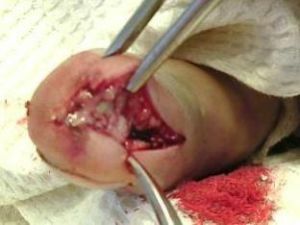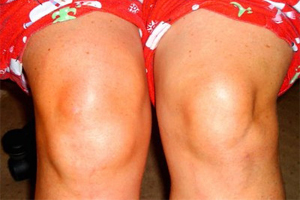 Movement is life! In this phrase lies a deep meaning, because to maintain their vitality and meet physiological needs a person needs to move.
Movement is life! In this phrase lies a deep meaning, because to maintain their vitality and meet physiological needs a person needs to move.
Every day, a person makes hundreds of movements, the possibility of accomplishing which provide joints.
The functioning of the knee joint is necessary to ensure normal motor activity of the human body.
Despite the fact that the knee is the largest joint in the human body, it is very fragile. Fragility is explained by knee-bending with great physical exertion and exposure to external influences.
Contents of the article
- A brief course in the anatomy of
- What are the reasons?
- Characteristic signs of the
- problem Perhaps you are at risk
- So what should I do?
- Arthrocenez: what is the essence of the procedure?
- Grandmother's recipes - why not?
Short course in the anatomy of the
The knee joint( knee) is the connection of three bones: the femur( from above) and the tibia( bottom) bones, patella or knee cap( front).
Femoral and tibia bones are joined by two menisci - cartilaginous layers of the half moon shape, increasing the area of contact of bones.
A stable position of bones relative to each other is provided by ligaments: anterior and posterior cruciate ligaments, tibial and peroneal ligaments. 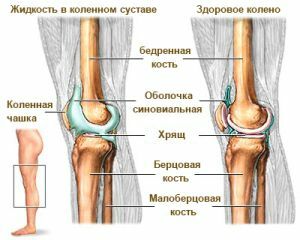
The joint is located in the capsule. Its inner layer is called synovial membrane( synovia).
It is the synovium that produces the synovial fluid, which is a kind of shock absorber, which reduces the external action, which feeds the cartilage, which ensures the circulation of substances inside the knee joint.
Due to the impact of negative factors, synovia becomes inflamed, which leads to excessive production of synovial fluid, as a result of which fluid accumulates inside the joint.
Liquid can have different nature( serous, purulent, fibrinous, hemorrhagic).
What are the reasons?
The causes of accumulation of fluid in the knee are many, ranging from infectious diseases, ending with knee injuries.
The most common cause is trauma caused by a sharp impact on the knee joint( jump, fall, stroke, etc.).These include:
- meniscus damage;
- hemarthrosis( hemorrhage);
- stretching, ligament rupture;
- knee injury;
- fracture of patella.
The most common cause is the rupture of cruciate ligaments.
Such fractures are sometimes accompanied by fractures of bone plates at the attachment points of the ligaments, kneading the knee, resulting in the limb losing its musculoskeletal function.
As a result of rupture of cruciate ligaments, severe pain appears, and a hemorrhage to the joint( hemarthrosis) may occur.
Also a common cause of fluid accumulation are chronic joint diseases: arthritis, rheumatism, rheumatoid arthritis, gout.
Another cause of synovitis of the knee joint is purulent inflammation, which causes bursitis. Pus is formed as a result of the vital activity of pathogenic microorganisms entering the body through open wounds or with blood flow.
The most rare cause of excess fluid in the joint is the allergic reaction of the body to various allergens.
Symptoms of
Symptoms that accompany fluid accumulation:
- acute pain and feeling of pressure inside the knee;
- increase in knee size: swelling, swelling;
- inflammation of the knee joint is sometimes accompanied by fever and irritation of the skin on the knee;
- restriction of the motor function of the legs.
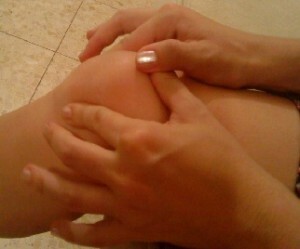 The first symptoms appear after a short time after injury to the joint.
The first symptoms appear after a short time after injury to the joint.
First of all, there is swelling, which is accompanied by pain in the knee area. Then an excess fluid deforms the knee joint, which leads to a limitation of its mobility.
Doctors distinguish several groups of people at risk.
Perhaps you are at the risk of
The most likely accumulation of excess fluid in the joints of the following people:
- People with overweight obese .Exposure to the inflammation of the synovium is associated with a colossal load on the knee, caused by excess weight. Under the influence of weight, cartilage can be damaged, resulting in inflammation of the synovium and accumulation of fluid.
- People involved in sports and leading an extreme lifestyle .Athletes are more likely to get knee joint injuries due to heavy loads on their legs.
- People of retirement age .With age, body tissues lose their elasticity, which leads to their exhaustion. Due to age-related changes in the body, orthopedic joint diseases develop, which provoke synovitis.
Otherwise, normal provision of the motor function of the limb will be impossible.
So what should I do?
To date, there are two main methods of traditional treatment of diseases associated with excess fluid in the knee joint: conservative( use of medicines) and surgically.
As a separate method, a puncture or arthrozenesis is isolated. The most effective combination of these methods.
Surgical intervention is an extreme measure and is only used in neglected cases. Therefore, the earlier synovitis is revealed, the greater the chances of maintaining the integrity of the joint and the motor function of the legs.
With conservative treatment, anti-inflammatory drugs are prescribed, eliminating pain symptoms and swelling of the joint.
Drugs are taken either inside or locally in the form of ointments, with purulent inflammation appoint a course of antibiotics to kill the infection.
Arthrocenez: what is the essence of the procedure?
To date, the procedure of puncture( puncture) is widely used. 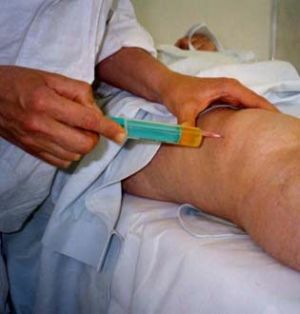
The procedure for puncture the fluid of the knee joint is called arthrocenez. Apply this method for further diagnosis, and for removing fluid.
This procedure is performed under local anesthesia and involves pumping out excess fluid, pus or blood using a special syringe with a needle.
After a puncture, an antibiotic solution or an antibacterial drug is injected into the knee to prevent infection. Further treatment depends on the causes of fluid accumulation and is carried out under the strict supervision of a physician.
Grandmother's recipes - why not?
For the withdrawal of excess fluid and prevention of diseases of the knee joint can be used by folk remedies.
Below are the recipes tested by time:
- Compress with comfrey grass .To make the ointment, you need to take a glass of chopped comfrey with lard( 200 grams), mix them and put them in the refrigerator for 5 days. In the future, the compress should be applied in the morning and evening, rubbing it into the inflamed joint.
- Infusion of medicinal herbs : thyme, yarrow, mistletoe, eucalyptus, echinacea, chamomile( tansy), walnut, birch leaves. Herbs should be mixed in equal quantities. To prepare the infusion, pour 1 tbsp.l.collecting two glasses of hot water. The infusion should be infused for 1 hour, after which it can be consumed. It is necessary to drink three times a day for 150 ml with meals.
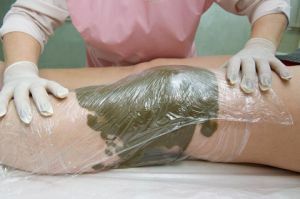
- Bay oil .For cooking you need 2 tbsp.l.dried laurel leaf and a glass of vegetable or olive oil. The resulting oil must be insisted for a week. Obtained oil must be filtered and massaged movements rubbed into the knee in the morning and evening.
- Tincture of black walnut .This tincture is used as a remedy against helminths, since the presence of a small number of helminths in the body can lead to the development of synovitis. Take infusion is necessary daily, a teaspoon before eating.
- Rye broth .To prepare the broth you need half a glass of rye, pour in running water and boil. Once the broth has cooled, add one tablespoon of barberry root, 150 ml of vodka and honey( 500gr).The resulting broth should be infused for three weeks. Take the broth should be 3 tablespoons 3 times a day before meals.
Traditional medicine effectively removes excess fluid from the knee, however, this is not enough to completely cure the concomitant disease.
If you find symptoms of synovitis you need, as soon as possible to seek the advice of a specialist.
Detection at an early stage of the development of the disease will avoid damage to the joint tissues, which will preserve the musculoskeletal function of the legs and avoid recurrence of the disease.

